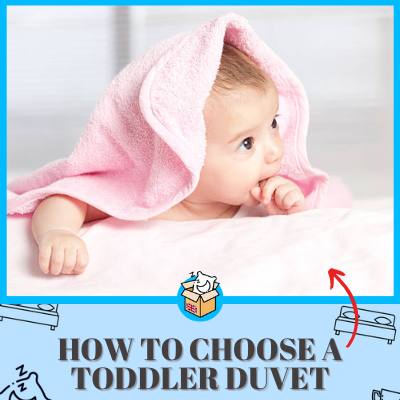Parents get worried when their toddlers don’t sleep properly at night. However, introducing a duvet to a toddler’s bed can significantly improve the situation.

Choosing the right bedding for your kid is essential to ensure they sleep well. As your kid grows into a toddler, you should get them out of their sleeping bags and introduce a toddler’s bed to their rooms. And a toddler’s bed requires the best duvet! So, we suggest that you find a year-round duvet to begin with.
However, we won’t be surprised if you tell us that you have no idea where to start looking and what to look for.
To choose the best duvet for your toddler, it is essential to keep a number of things in mind. And after reading this guide, you will be fully equipped with the knowledge to begin your quest to look for the perfect duvet.
Let’s begin!
Things To Look For When Choosing Best Toddler Duvets
1. Opt For A Light Duvet
Both babies and toddlers like to wriggle and play in their beds all throughout the night. As a result, there’s a higher chance of kids feeling hotter than we adults do. And in the morning, you might find them waking up on the other side of the bed.
Besides, they are not old enough to get up and change out of their Marvel pyjamas in the middle of the night if they feel hot. Therefore, it is essential to choose a cooler cot bed duvet for your kid. To help your child sleep peacefully through the night, you can opt for a 4.5 tog duvet for summertime and a 7.5 tog duvet for winter.
While choosing the cot duvet, you need to also keep the room temperature in mind. If you have just shifted to a new house in a tropical region, a 4.5 tog duvet might serve the purpose all year round. And on colder nights, you can just add an extra blanket and let your kid wear their favourite pyjamas. But if you stay in colder regions, consider going for a wool duvet.
2. Go For Natural Materials
Another way to ensure that your kid does not feel hot at night is to stay away from cheap synthetic duvets. We suggest opting for duvets that are made up of natural fibre, such as organic cotton, which feels wonderfully soft.
Natural fillings are always the safe option when it comes to toddler duvets. They are made with organic materials and will never put your child at risk. Most of the duvets with natural fillings either have British wool or organic cotton in them. These options are quite breathable and do not weigh down on your kid.
Organic and natural fillings also make for great all-seasons duvets. They trap the heat in winters and facilitate proper ventilation during summers.
3. Choose Synthetic Duvet Filling Wisely
Synthetic filling is a great bet when you are on the lookout for a lighter duvet for your younger children that can regulate their body temperature. The polyester filling has an open and airy texture which traps the heat. And because the material is not heavy, your child won’t feel uncomfortable.
As such, we suggest that you consider this option, especially for the colder months.
However, many parents do not consider synthetic filling for their toddler’s duvet to reduce the risk of allergies. But if you have already bought one, consider putting an outer bamboo cover or something similar on it to make it more comfortable for your little allergy sufferers.
And if you’re yet to get one, always check if the duvet comes with a British Allergy Foundation seal, there’s no way your child will face allergic reactions.
That said, if your child shows serious allergy symptoms, we suggest you do not consider this option. Some options (like synthetic duvets) can come with feather fillings as well, which should also be avoided if your child suffers from allergies. In case your kid has very sensitive skin, do some research and find naturally hypoallergenic materials for the duvet.
We’d strongly recommend getting an anti-allergy duvet to ensure that they get to enjoy a night of undisturbed sleep.
4. Opt For Washable Materials
Try getting your hands on a washable duvet (especially one that can be machine washed) if you want to avoid trouble at night. Kids soiling their beds in the middle of the night is nothing new, and that often leaves the parents in a frenzy. Now, imagine being stuck with a winter duvet in a toddler bed that takes hours to dry!
When a duvet is dirtied, you will have to immediately give it a wash in your washing machine. Hence, you should opt for a duvet and pillow that does not take too long to dry or can be tossed in a tumble dryer.
5. Choose A Cot Bed Size Duvet
To ensure that the duvet does not fall out of your toddler’s cot, go for a cosy duvet that is a little larger than the cot size. The universal size of kid’s duvets is 120×150 cm. However, if your kid’s cot is small in size, you can consider opting for a single-sized duvet instead. To sum it up, always try to make sure that the duvet is of the right size.
If it is bigger than what it should be, your kid might end up feeling hot at night.
Cot Duvet Options To Consider
After consulting experienced parents and searching the market for the best toddler duvets, we have come up with some of our favourite options that you can try. Let’s take a look!
1. Panda Kids Duvet

If you are looking for a lower tog duvet, we suggest that you give this product a try, which is made of bamboo microfibre (50% bamboo and 50% microfibre filling). This makes it an antibacterial option, which helps prevent the build-up of mildew and dust mites.
Plus, it’s suitable for both the summer and winter months, as it adjusts to your kid’s body temperature and the weather outside. This duvet has the standard 120x150cms dimension and should fit your kid’s cot perfectly. However, to be safe, always take the dimension of the cot beds before making the purchase.
2. John Lewis Toddler Pillow and Duvet
When it comes to your kids, there’s no doubt that you will always choose nothing but the best. And this is a lightweight duvet that can be the ideal first buy for your kid’s cot. The best part is that it comes with a pillow set too!
Moreover, we were impressed with the quick-dry feature of the duvet. Even if your kid soils it at night, it won’t be too much trouble to wash and dry it in a short time. And because this is machine-washable, you do not even have to put too much effort into cleaning it.
This is 100% cotton and can be used as a coverless duvet.
What To Remember For Choosing The Best Toddler Duvet
You might get the perfect cot bed for your kid when they are of the right age. However, without a suitable duvet, their bedding will stay incomplete. When choosing a duvet for your toddler’s cot bed, make sure that it is not too heavy and lets your kid wriggle without any hindrance.
If you are buying a duvet that comes with a pillow set, it is important to first check if the pillows are soft. Hard pillows can cause neck aches in children.
Moving on, we came across a lot of parents who have a hard time saying no to their kids wearing their favourite pyjamas to bed. No doubt, pyjamas are highly tempting during the winter months. However, they might make your kid feel hot at night. And as you must know, feeling too hot or cold can lead to your kids having a night of disturbed sleep.
Whatever the outside temperature is, you should always choose bedding that suits the temperature inside the room.
As we have already mentioned before, some of the most important things to consider when selecting a duvet are its weight, washability and material. Trust us; they are extremely crucial in determining how well your child will sleep at night.
Frequently Asked Question
1. Can a duvet make a toddler sick?
A big part of your toddler’s health is dependent on how well they sleep at night. Unless they get a good night’s sleep, there’s always a chance that they will fall sick. Some kids are more sensitive than others, and certain duvet fillings might trigger allergic reactions. So, to tackle this problem, we suggest that you use only those options that come with antiallergic features.
These duvets are built in a way that they effectively prevent the build-up of dust, mites, fungi and bacteria.
2. Should you tuck your toddler’s duvet in?
Absolutely! It is natural for kids to wriggle and throw off the duvet at night. To prevent that from happening, it is best to tuck the duvet in between the bed frame and the mattress. This will keep the duvet in place, and your toddler will have enough room to move freely under the duvet.
3. When to introduce a duvet to a toddler? (NHS Guideline)
We suggest that you follow the NHS advice and prevent babies under one year of age from using duvets and pillows. Kids who are below one year of age cannot move freely in their beds and risk suffocation if there are duvets or pillows around.
Once your kid is over 18 months, you can consider introducing a duvet to their bedding. And you should only introduce a pillow when your toddler’s head is wider than their shoulders. That is when they will really enjoy resting their head on a pillow.
4. Is it necessary to use duvet covers?
While there is no strict rule to using a cover for your toddler’s cot, we suggest using one that is soft and plush, and adds extra comfort. If your kid has sensitive skin, we suggest that you choose a linen or cotton cover.
Pre-washed linen covers are soft right from the beginning and do not collect lint. Therefore, you can use them for a long time.
Another reason to add a duvet cover to your child’s bedding is that it makes maintenance super simple. If your toddler dirties the cover, you can simply take it off the duvet and give it a quick wash. This won’t be possible if there is no cover and you have to wash the entire duvet. Also, it goes without saying that the covers dry much faster than the duvets.
5. What tog duvet should a three year old have?
As we have mentioned before, when introducing a duvet to your child, select one that comes with a 4.5 rating. However, as your toddler grows up, you can gradually increase the tog. On average, for a three-year-old, a duvet with a 6-tog rating might be the best bet.
We suggest that you do not go above a 10.5 tog rating, as that might make your kid feel uncomfortable at night.
Final Words
With that, we have finally reached the end of this informative guide!
We understand that every kid is different, and there is no one better than you to understand your toddler’s requirements the best. However, we must tell you that a duvet is not the only factor that determines how well your child sleeps.
To ensure they get good sleep and stay healthy, try to build a proper bedtime routine for them. You can add block curtains to their room to keep natural light out during the warmer months. Following a proper bedtime routine will improve your toddler’s nights and mornings too.
Until next time, take care of your little ones!
 Nectar Mattress
Nectar Mattress 


